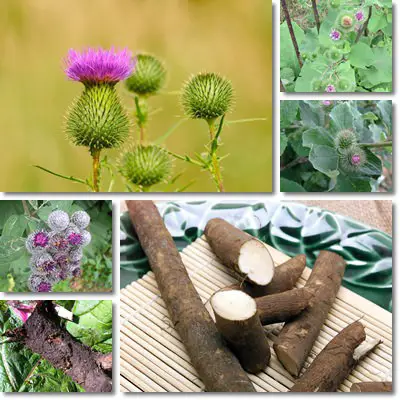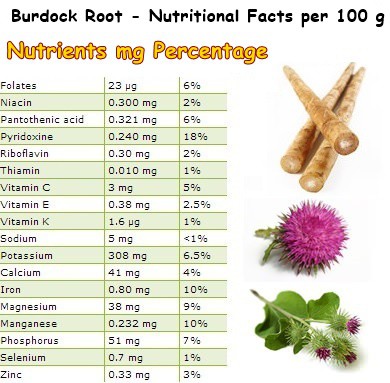Burdock (Arctium) is a family of biennial plants widely spread throughout Europe and Northern Asia, highly valued in both traditional and modern medicine. In the past, burdock roots were used to purify blood, treat rashes, eczema, colds and improve digestive health. Both the roots and the leaves are now widely consumed as culinary vegetables, while burdock flowers are made into herbal infusions meant to help treat respiratory tract infections, digestive upset and help stabilize blood sugar levels.
Recent studies have shed light on the amazing antioxidant properties of burdock and have revealed that certain components in the plant may prove efficient in treating various forms of cancer, diabetes and even AIDS. Different preparations of the plant have been shown to help support kidney function and digestion, relieve constipation and promote overall good health. Burdock root is a known hepato-protective agent and detoxification medicinal plant and was consumed for this purposes for hundreds of years.

What is burdock?
Burdock is actually a family of Asteraceae or daisy plants, widely spread in temperate climates throughout the world. It is related to dandelions and chamomile. Common names include gobo, edible burdock, greater burdock and lappa. Burdock plants can reach heights of almost 3 meters and have wide, dark green leaves and lavender-indigo flower heads. While many people believe burdock to be a troublesome weed, the plant is actually an appetizing vegetable and a good source of essential nutrients required to keep us in good health.
What does burdock look like?
Burdock is a tall plant, reaching heights of almost 3 meters. It has large, dark green, heart-shaped leaves and small, thorny, purple-lavender flowers. The root, called a taproot, can grow up to 1 meter in length and is dark-brown in color. Burdock root, leaves, shoots, seeds and flowers (in teas) are all edible.
What does burdock root taste like?
Burdock root has a mild, slightly earthy flavor and a crunchy, woody texture. It tastes a bit like artichoke or parsnip, although when cooked it tends to take on the flavor of the dressing, spice or sauce you add to it.
Burdock root cooking and other tips:
Eat burdock roots with skin and all. The skin has the most flavor and is the richest in nutrients so it might be best to give it a good wash and scrub, then use it whole. Because it turns brown quite fast, you might want to chop it and cook and eat it fast. Also, washing it causes the root to wilt faster which is why you will often find it full of dirt at farmer’s markets. The sooner the root is harvested, the more tender it is. Nevertheless, the more mature the root, the healthier it is because it concentrates more nutrients and active constituents.

What is burdock root good for?
Find out below what are the main nutrition facts and health benefits of burdock root:
Excellent kidney cleanser
Burdock root is an efficient diuretic, meaning it stimulates kidney function naturally, encouraging the excretion of toxins. This helps cleanse the kidneys and prevents water retention. Because kidneys filter blood toxins, burdock root indirectly purifies the blood. However, although it detoxifies the body and helps us lose excess water, if you are already dehydrated, you might want to postpone eating burdock root because its diuretic action may worsen dehydration.
Aids digestion
Burdock root contains inulin (not to be confused with insulin), a carbohydrate, polysaccharide and type of fiber also found in chicory, asparagus or bananas. Inulin basically promotes digestive health due to its prebiotic activity, meaning it stimulates the growth of healthy gut-bacteria (Bifidobacterium).
See the benefits of inulin.
It also promotes rehydration following severe diarrhea episodes and may aid in reducing Crohn disease symptoms. Burdock root also contains mucilage, which acts as a protection for the gastric mucosa and allows it to heal if, for example, it has been damaged by acidity or inflammation, common in conditions such as acid reflux or gastritis.

Restores appetite
Burdock root is known to stimulate and restore appetite and is thus recommended for gaining weight and promoting recovery following prolonged illness. The root itself is a good source of nutrients such as vitamin B5, B6 and B9, vitamin C, potassium, iron, magnesium, manganese and phosphorus.
Good for constipation and colon health
Eating burdock root helps prevent and relieve constipation and promotes colon health. Burdock contains about 3.3 g of dietary fiber/100 g of raw root. Dietary fiber not only prevents and treats constipation due to its strong laxative effects, but also limits the time our colon is exposed to the toxins in stools, contributing to its overall health.
Anti-inflammatory and anticancer properties
According to recent research, burdock roots are a rich source of antioxidants, notably tannins and the flavonol quercetin. Antioxidants scavenge damaging reactive oxygen molecules known as free radicals and help reduce inflammation markers. Preliminary in vitro laboratory studies have revealed that burdock root extracts have shown great promise in inhibiting tumor cell proliferation and reducing blood sugar levels in diabetics. Although research is poor, it is suggested that special compounds in burdock root may also stop the proliferation of the HIV virus.
Natural remedy for respiratory tract problems
Burdock root is a great diaphoretic and is used to induce sweating, or diaphoresis, with the purpose of reducing fever. The process of diaphoresis not only brings fever down, but also activates blood circulation and promotes the elimination of toxins through the skin. Also, burdock root tea helps ease nasal congestion and maintains healthy lymph tissues at the gut level, supporting the immune system function and supporting recovery from respiratory tract infections.
Calms rashes and treats eczema
Traditionally, burdock root tinctures, decoctions or poultices were applied on the skin to calm rashes and help treat skin problems such as eczema, abscesses or psoriasis. However, it is not recommended to apply any burdock root extract on open wounds.
As seen in the nutrition table above, burdock root is a good source of essential nutrients such as vitamin C, B vitamins, iron, manganese, magnesium, phosphorus and potassium which contribute to good overall health. Burdock root is a favorite of Japanese cuisine and, as you may already know, the Japanese are among the most longevous people in the world with one of the highest percentages of healthy centenarians.
Side effects and contraindications
Burdock root and pregnancy
Pregnant women and nursing mothers are advised to avoid burdock root. While otherwise healthy, the plant may hold side effects for the fetus and newborn child. As a general recommendation, talk to your doctor first if you are pregnant or nursing and looking to include burdock root into your diet.
Burdock root and allergies
Since burdock is a member of the daisy family, it can cause allergic reactions in some people, likely those also allergic to other plants in the daisy family (example: chamomile, Echinacea or coneflower). However, very few cases have been reported, both because burdock is not a common allergen and because it isn’t one of those foods everyone eats. Burdock is indeed extremely healthy and may prove a valuable addition to many diet. Nevertheless, always remember to practice moderation with everything you eat. So enjoy your burdock root, but make sure intake is reasonable.
